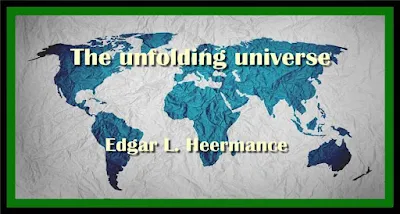The unfolding universe
What is the universe of which we are a part? What is its meaning? What is our life, and whence, and whither? These questions are perennials; they spring up year after year without our planting. Not so with the answers.
Man must wring them from a reluctant Nature by the sweat of his brow. This book attempts to sketch the contributions made by the various sciences toward a philosophy of the universe. It grows out of the conviction, to which philosophy has been strangely blind, that the inductive method is the only method of thinking which is reliable or fruitful.
Scientific study has opened up the rich fields of modern thought by driving observation and hypothesis abreast. Why should science have a monopoly on such a team? I offer this book as the outline of inductive philosophy. The task of the sciences is to gather facts in their respective fields.
The function of philosophy is supposed to be to interpret those facts and arrange them into a consistent whole. If philosophy is in bad repute in many quarters, it is because she has forgotten her place as the handmaid of the sciences.
Learned men find it easy, sitting in their studies, to think what the universe ought to be like, or to build an eclectic philosophy, stone by stone, out of tlie ruined systems of the past. But — to change the figure — while the professional philosopher has been spinning his gossamer theories of matter and life, the physicist and the biologist have been studying matter and life and making remarkable discoveries as to their texture.
Much the same is true in the broad field of psychology. The philosophy that men want today, I believe, is the philosophy which, on the foundation of what is known to us through the several sciences, builds its inductions as to the unknown beyond them all. Within two decades almost every science has passed through a period of revolution.
We live in a new intellectual world. The attempts at inductive philoso- phy made a generation ago are as out of date as textbooks in physics or neurology or comparative mythology of the same vintage. Doubtless, some will say that it is too early to frame the new knowledge into a system of philosophy. But that same new knowledge is already modifying our thinking. In scientific books and papers of today, in scouting expeditions into the realm of science like those of James and Bergson, are to be found the beginnings of new and strange philosophies.
Some contents:
INTRODUCTORY
CHAPTER I
KNOWING THE WORLD
Ideas valid only when concretely applied, 3. Theories must be derived from observed facts, 4. The possibility of knowing, 5. A typical scientific induction, 6. Philosophy must adopt the inductive method, 7. The relativity of knowledge, 8. Philosophical scepticism, 9. Knowledge an adjustment to the external world, 10. Kant's view of the idea of space, 11. Space as interpreted through child and animal psychology, 12. Stages of mental adjustment: percepts and their objective validity, 13. Recepts, 15. Concepts, 17-
PART ONE. THE PHYSICAL
CHAPTER II
THE STARS
The physical group of phenomena, 21. The stellar universe of limited extent, 22. Number and distribution of the stars, 25. Classification, 27. Double stars, clusters, variables, 28. The nebulae, 30. Stages of stellar evolution, 31. The action of tides, 33. Meteoric hypothesis, 34. Electrons, 35. The life of a star, 35. Contribution of astronomy: the world unity, 36. A finite universe, 37.
CHAPTER III
ELECTRONS
The atomic theory is now proved 39. Structure of the atom: discovery of electrons, 39. Radioactivity, 42. Atoms in the making, 46. Mass of the electron is due to its motion, 4$. Is the mass of the positive ion electro-magnetic? 47.
CHAPTER IV
IS THERE AN Aether?
The aether theory, 49. Is the aether in motion ?_ 50? As- sumptions of the Newtonian mechanics, 51. The principle of relativity, 52. Mass is now regarded as a function of the velocity, 54. The collapse of the aether theory, 55. Rejection of the idea of infinity, 56. The new mechanics and its units, 56. The category of number, 57. Space as measurable relation, 57. Time as measurable sequence, 59. A limited universe and the conservation of energy, 60.
CHAPTER V
THE UNIVERSAL ENERGY
Classification of forces: A. Electrical attraction, 61. B. Magnetic attraction, 61. C. Pressure of radiation, 62. D. Molecular attraction, 62. E. Gravitation, 62. Forms of kinetic energy: i. Electrical, 63. 2. Magnetic, 64. 3. Radi- ant, 64. 4. Molecular, 64. 5. Molar, 65. Law of the conservation of energy, 67. Is the universe running down? 67. Probable identity of matter and force, 68. The universal energy, 69. Uniformity and intelligence, 70. Physics can tell us nothing as to plan and purpose, 72.
PART TWO. THE ORGANIC
CHAPTER VI
THE EVOLUTION OF LIFE
The physical history of the earth, 75. Simplest existing forms of life; the vegetable kingdom; higher protozoa, 78. Metazoa, 81. Vertebrates, 83. Mammals, 85. Species and varieties, 87. Physical and social environment, 88. Wide range of experimenting^ in nature, 89. The origin of species: weakness of Darwin's summation theory, 90. Mutations, 91. Mendel's law allows mutations to survive cross-breeding, 92. The true place of natural selection, 93. The origin of mutations is still unsolved, 94. The gradual perfecting of species, 95. Evolution a grand laissez faire, 96. Changes on earth's surface due to the presence of life, 96.
the book details : 
